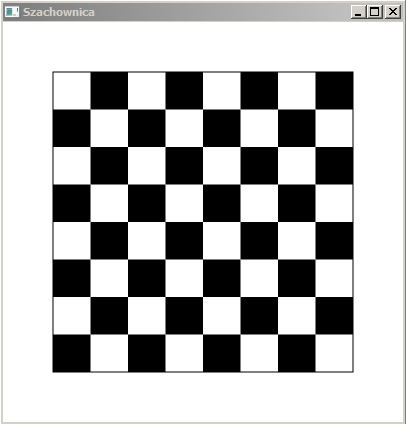FXML tutorial (22) – element JavaFX Canvas w FXML
Listing22_Controller.java
package codes; import javafx.fxml.FXML; import javafx.fxml.Initializable; import javafx.scene.canvas.Canvas; import javafx.scene.canvas.GraphicsContext; import javafx.scene.paint.Color; import java.net.URL; import java.util.ResourceBundle; public class Listing22_Controller implements Initializable { @FXML private Canvas cv ; private GraphicsContext gc ; @FXML private void drawChessboard(double x, double y, double size) { for (int i = 0; i < 8; i++) { for (int j = 0; j < 8; j++) { if ((i + j) % 2 != 0) { gc.fillRect(x, y, size / 8.0, size / 8.0); } gc.translate(size / 8.0, 0); } gc.translate(-size, size / 8.0); } gc.strokeRect(x, y - size, size, size); } @Override public void initialize(URL location, ResourceBundle resources) { gc = cv.getGraphicsContext2D(); gc.setFill(Color.BLACK); gc.setStroke(Color.BLACK); gc.setFill(Color.BLACK); gc.setStroke(Color.BLACK); drawChessboard(50, 50, 300); } }
listing22_canvas.fxml
<?xml version="1.0" encoding="UTF-8"?> <?import javafx.scene.canvas.Canvas?> <?import javafx.scene.Group?> <Group xmlns="http://javafx.com/javafx/19" xmlns:fx="http://javafx.com/fxml/1" fx:controller="codes.Listing22_Controller"> <Canvas fx:id="cv" height="400" width="400" /> </Group>
Listing22_xanvas.java
Klasa uruchamiająca.
package codes; import javafx.application.Application; import javafx.fxml.FXMLLoader; import javafx.scene.Group; import javafx.scene.Scene; import javafx.stage.Stage; import java.net.URL; public class Listing22_canvas extends Application { public static void main(String[] args) { Application.launch(args); } @Override public void start(Stage stage) { try { URL fxmlUrl = this.getClass().getClassLoader() .getResource("resources/listing22_canvas.fxml"); Group root = fxmlUrl != null ? FXMLLoader.load(fxmlUrl) : new Group(); Scene scene = new Scene(root, 400, 400); stage.setScene(scene); stage.setTitle("Szachownica"); stage.show(); } catch (Exception e) { e.printStackTrace(); } } }
Po uruchomieniu zobaczymy:



